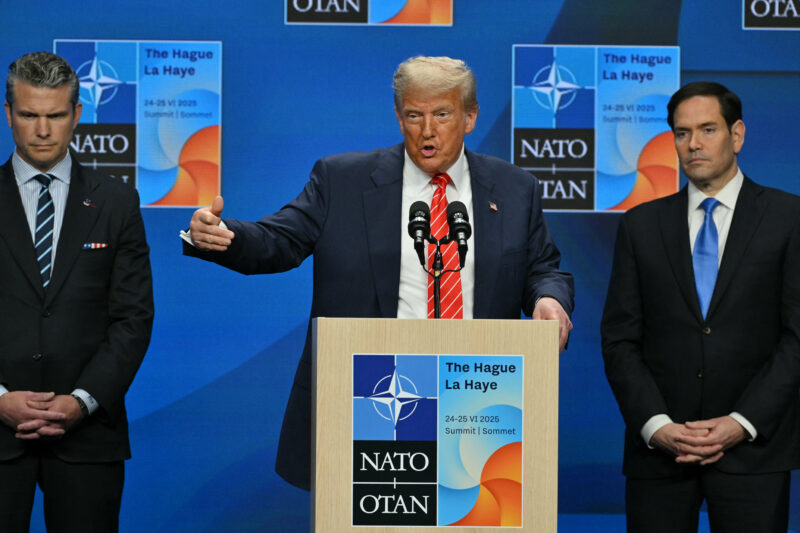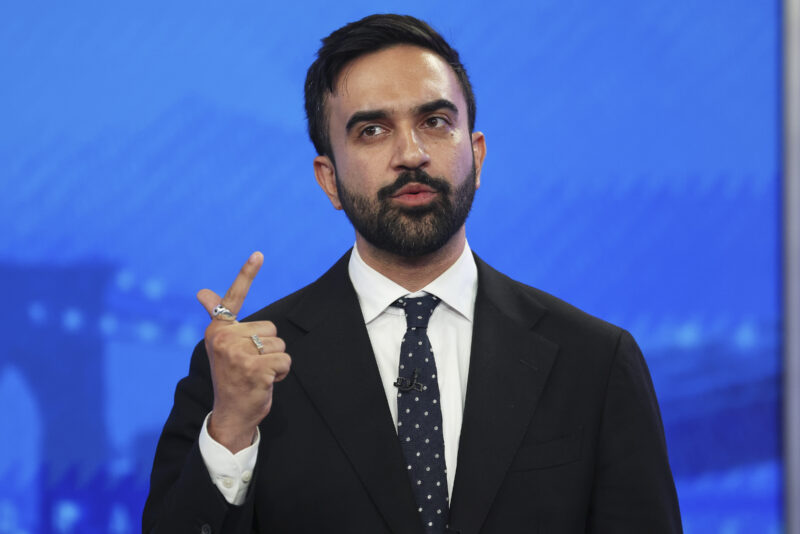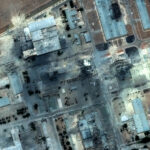Israel strikes offline nuclear reactor in Arak

JOHN WESSELS/AFP via Getty Images
Smoke billows from Soroka Hospital in Beersheba in southern Israel following an Iranian missile attack, on June 19, 2025.
Iranian ballistic missiles struck Soroka Hospital in Beersheba in southern Israel and sites in the Tel Aviv area on Thursday morning, wounding 89, including three seriously.
A missile struck the hospital’s old surgical building, severely damaging it and causing what a Soroka spokesperson described as “extensive damage in various areas” of the hospital complex. The surgical building had been recently evacuated in light of the war, and patients and staff had been moved to areas with reinforced walls. Injuries from the strike were light, hospital representatives said.
Soroka is the largest hospital in the Negev, such that the strike left a large swath of Israel without a functioning major medical center. Other hospitals in the area, including Barzilai Medical Center in Ashkelon and Assuta Medical Center in Ashdod, prepared to take in patients from buildings that were damaged. Magen David Adom provided four intensive care buses, able to transport a total of 23 ICU patients and 50 lightly injured casualties.
Israeli Foreign Minister Gideon Sa’ar wrote that “The Iranian regime fired a ballistic missile at a hospital. The Iranian Regime deliberately targets civilians. The Iranian regime is committing war crimes. The Iranian regime has no red lines.”
Prime Minister Benjamin Netanyahu posted on X that “Iran’s terrorist dictators shot missiles at Soroka Hospital in Beersheba and the civilian population in the center of the country. We will make the dictators in Tehran pay the full price.”
Israeli Defense Minister Israel Katz said in a statement that the price would be to destabilize the Islamic Republic’s regime.
“The prime minister and I instructed the IDF to increase the force of the attacks against strategic targets in Iran and against governmental targets in Tehran to remove the threats to the State of Israel and undermine the Ayatollahs’ regime,” he stated.
Iranian news agency IRNA claimed that the target of the strike was an IDF intelligence outpost in Beersheba’s HiTech Park, which is over a mile away from the hospital. A television channel tied to the Islamic Revolutionary Guard Corps said that the missile was aimed at a “military hospital” in response to strikes on “civilian hospitals” in Gaza.
In the same 30-missile barrage, Iranian missiles struck a school in Holon. No children were present, because schools have been closed across Israel since Friday, but three elderly residents of adjacent buildings were wounded in serious condition, in addition to 62 others with minor to moderate injuries.
Another missile struck near the Ramat Gan Diamond Exchange, abutting Tel Aviv, causing minor injuries to 21 people and damage to 20 buildings in the neighborhood, which includes some of Israel’s tallest buildings.
Shrapnel struck Sheba Medical Center, Israel’s biggest hospital, also in Ramat Gan.
Overnight, the IDF intercepted several drones launched by Iran at Israel towards central and northern Israel.
Jordanian authorities reported that an Iranian drone fell in a shopping center north of Amman, damaging a car and a bus station. Syrian media reported that an Iranian drone was shot down over the country.
The IDF struck an inactive nuclear reactor near Arak in Iran early Thursday after sending warnings to civilians in the area. The IDF Spokesperson’s Office said the strike included “the structure of the reactor’s core seal, which is a key component in plutonium production.”
“The strike targeted the component intended for plutonium production, in order to prevent the reactor from being restored and used for nuclear weapons development,” the IDF Spokesperson’s Office said.
The IDF also gave details of strikes on the active nuclear site in Natanz, which “contained components and specialized equipment used to advance nuclear weapons development and projects designed to accelerate the regime’s nuclear program.”
In addition, 40 IAF fighter jets struck dozens of military targets in Tehran and other parts of the country, including factories manufacturing ballistic missile and air-defense components, as well as air-defense batteries, surface-to-surface missile storage sites, radar systems and other targets.
IDF Chief of Staff Lt.-Gen. Eyal Zamir sent a letter of encouragement to IDF soldiers and commanders on Thursday, saying that they are “writing a new chapter in history for the State of Israel and the entire Middle East.”
”Thanks to a decisive and impressive surprise opening strike, we have achieved tremendous goals: We eliminated the regime’s command echelons, delivered a deep blow to the capabilities used for the Iranian nuclear program, identified and struck missile launchers, and we are continuing and increasing the strength of our operations as necessary,” Zamir wrote.
Iranian news reported that the country’s military shot down a second Israeli Hermes Drome. The IDF confirmed that Iran downed the first UAV a day earlier.
Israel’s Home Front Command loosened restrictions on Israelis on Wednesdays, allowing people to return to workplaces with safe rooms and for up to 30 people to attend synagogue at a time. Schools and kindergartens remained closed.
A poll published by the Israel Democracy Institute found that 70% of Israelis support the campaign launched against Iran last week, while 10% support the campaign but think the timing is wrong and 13.5% oppose it. Among Israeli Jews, 82% support the strikes, whereas only 11% of Israeli Arabs do, according to the poll. Jewish Israelis across the political spectrum support the operation: 57% of those who self-identify as left-wing, 75% of centrists and 90% on the right.
Though in past polls, most Jewish Israelis did not think Israel should strike Iran without help from the U.S., this week 69% thought it was the right decision. In addition, 68% of Jewish Israelis thought that Netanyahu’s motivation behind launching the operation against Iran was security-related, while 68% of Arab Israelis thought it was political.
The poll was conducted this Sunday-Tuesday among 594 Israelis, with a 3.61% margin of error.
The Jewish text-sharing platform has developed a prototype for applying its model globally

Homepage for Sefaria 'Democracy' Project
The Mishnah meets the American Revolution?
Sefaria, a non-profit that provides public domain access to Jewish texts and commentary, has developed a prototype of its highly praised model to bring its technology to other bodies of work — starting with the U.S. Constitution.
In addition to providing primary source material, Sefaria, founded in 2013 by Google developer Brett Lockspeiser and author Joshua Foer, maintains a user-friendly interface and software to highlight interlinking references and citations throughout Jewish scripture.
“I think we were really inspired by the shape of Torah itself. The Torah tradition has this texture and shape that the printed ‘Vilna Shas,’ the printed Talmud, really has this visual sense of,” Lockspeiser, who serves as the organization’s chief technology officer, explained to Jewish Insider.
“All along, we’ve had in the back of our heads that the software that we’re building isn’t necessarily specifically about Jewish content,” he continued. “It’s something that applies to any body of text where you have lots of voices kind of in communication and dialogue with one another.”
Sefaria, working with a grant from the Lippman Kanfer Foundation, developed a prototype of its model with texts related to the birth of American democracy. The group chose the United States Constitution as an example, partly for its robust links to other noted texts but also because the Constitution and related texts already existed in the public domain. Lockspeiser emphasized this was only an initial example, mentioning the works of Shakespeare, Greek and Roman literature, medical texts, and texts of other religions as potential future projects.
Just as with its original platform, the goal of Sefaria will remain the same: to promote learning by providing free access to primary and secondary sources. Lockspeiser said he and others on the team have already spoken to experts about the unlimited future potential.
Tamara Mann Tweel, a professor in Columbia University’s American Studies Program, spoke glowingly of Sefaria’s new direction.
“The project will benefit teachers and students across the country by allowing them to access their rich democratic inheritance and converse with the great political and literary minds who have helped build that inheritance,” Tweel told JI. ”Sefaria took the infrastructure built for our Jewish textual tradition and gave it to our democratic one.”
Currently, the prototype website — which also lists works including the Declaration of Independence, Madison’s notes from the Federal Convention, the Magna Carta and important Supreme Court decisions — appears bare-bones, especially in comparison to the complexity of its mother site.
Still, the possibilities for future development are immediately apparent. While Lockspeiser admits there remain “a million steps,” before the site is ready for mass use, the Google alum is enthusiastic about the progress.
“I think we’re being really successful right now at the initial demo moment,” he said. “You look at it and you’re just like, ‘This is interesting. This is cool. There’s something here.’ And that’s the seed of a project being successful.”

























































